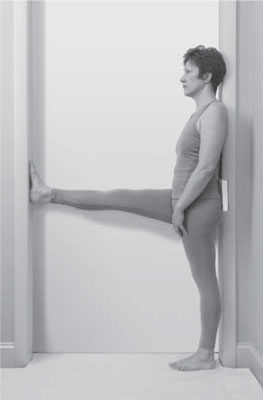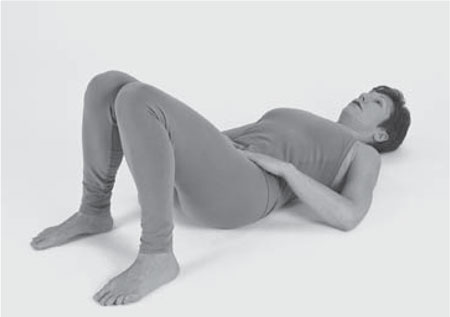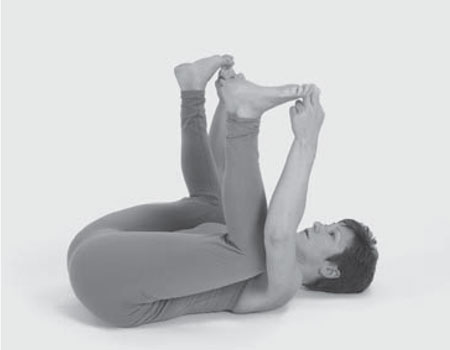Yoga for a Healthy Lower Back (18 page)
Read Yoga for a Healthy Lower Back Online
Authors: Liz Owen

A healthy forward bend will create length in the sacral joints and lumbar spine, and maintain the integrity of your sacral joints.
Try the following little experiment to feel this in your own body. Stand tall with your feet about hips' distance apart. Place your fingertips right where your thighs meet your hips, at the crease of your front groins. Without
pivoting your feet, turn your upper thighs inward so your pubic bone starts to move back toward your tailbone. Start to bend forward and feel what happens in your groins and to your fingers. Do your groins soften and deepen back toward your back hips and do your fingers move deeply into the soft folds of the skin and myofascia? This is the feeling you want in a forward bend, the feeling that your hip musculature is able to soften and release, bending from the hip joints.
If you can't get this feeling and find that the forward bend is happening somewhere in your lower or middle back, your hamstring muscles may be tight. Your hamstrings are three long muscles that begin at your sit bones, run along the backs of your thighs, along the backs of your knees, and connect to your lower leg. They are what allow your knees to flex and extend.
6
But if they're tight, they can inhibit your ability to bend forward from your hips. If this happens in your body, try again, this time disengaging your hamstrings by bending your knees. Can you feel the fold at your front hip creases now? Once you're comfortable in your bend, slowly and mindfully straighten your legs one at a time and notice any changes in your body position. Were you able to keep the bend at your hips as you straightened your legs, or did the bend move up from your hips into your lower and middle back?
This should be an
aha!
momentânow you can understand the relationship between your hips and hamstrings, and their effects on your sacrum. Practicing yoga will lengthen your hamstrings and tone your hip flexors so that over time you will be able to maintain forward folding from your hip joints.
The most important thing you can do as you experience the practice in this chapter is to be kind to your sacrum. Even though I just described movements to release and strengthen your sacrum, you may find that twisting, for example, irritates your already tender sacral band. Listen to your body, and give it permission to hold off on poses that bring pain or discomfort. Remember the maxim that health is a journey as well as a destinationâas you grow in your practice, you will find yourself able to do more and more movements, and to do them in more and more comfort. Your sacrum is an incredibly complex area, and it can take a bit of patient self-study to find out what will help it heal.
Long-lasting sacral wellness is a combination of balanced strength and flexibility of the myofascia, joint mobility, and structural alignment. When
you create wellness in your physical sacrum, you pave the way for wellness in the energetic channels we discussedâthe Ida, Pingala, and Sushumnaâso that powerful Kundalini energy can flow easily through the Svadhisthana (sacral) chakra. Listening to the messages from your sacrum will help you to understand what is happening and what it needs; then you can embark on your journey to bring health to the heart of your spine.
Y
OGA
P
OSES FOR A
H
EALTHY
S
ACRUM
Ask and Listen: Preparation for Practice
Standing Sacral Meditation
Stand tall with your feet about hips' distance apart, and bring your body into its natural alignment. Take your hands onto the back of your hips and place your thumbs on your sacral joints. Gently massage the joints with your thumbs and observe the feelings that come, asking yourself some questions to help you discern the condition of your sacral joints. Be sure to simply observe the sensations as you do this exercise; do not let judgment or anxiety color your exploration. Sway your hips gently to one side and then to the other and contemplate these questions:
â¢Â  Are your sacral joints comfortable?
â¢Â  Do they feel even with each other, or does one side feel higher, lower, or farther back than the other?
â¢Â  Do you feel soreness, tenderness, or pain on one side or the other?
Now take your hands so your fingers face downward on your buttocks, supporting your sacral joints in the palms of your hands. Experiment with very gentle back-bending, forward-bending, and twisting movements, and observe how your lower back feels. When you come into a slight backbend, is there pain at your sacral band, the horizontal area that goes across your sacral joints, or does the motion feel soothing? Do you even feel a bend at your sacral joints, or do they stiffen as your body instinctively goes into an arch in your lower back? How does it feel when you bend forward? How does it feel in your sacral joints when you bend to the right and to the left? When you twist to the right and to the left? If pain comes in any of these
movements, don't push farther into them; the work here is to simply note what triggers your pain.
As you move your trunk around your hips, making mental notes of which actions feel comfortable and which cause discomfort, begin to visualize the specific imbalances in your sacral joints. Now as you practice poses to help with sacral pain, you can include only those that help you feel better, and let go of ones that create discomfort. As your sacrum becomes stronger and more stable, you'll be able to add those poses back into your sequence, and you will experience them with comfort.
Doorway Stand
Find an opening between two walls or a doorway that's between three and four feet wide. Stand against one side of the opening. If it is a narrow doorframe, be sure your sacral joints are both fully supported. If the doorframe isn't flat, place a sturdy book behind your hips so you can feel both hips evenly pressing into the surface you are standing against. Place your hands on your hips and bring them into neutral position, with your hips level both to the floor and against the doorway. The goal, if possible in your body, is to start this pose with your hips and sacral joints all in alignment, and with your lumbar spine in its natural, gentle inward curve.
Bend your right knee and lift your right leg up, bringing your foot against the other side of the doorway. Place your foot directly opposite your right hip, or as close as you can get while keeping your hips level and maintaining the natural curve of your lumbar spine, then press your foot into the doorframe (
fig. 3.1
). Mentally examine your hips. What happened when you lifted your foot? Did your hips stay level, or did your right hip hike up, shortening the musculature on the right side of your back and torso? Rebalance your hips if that's the case in your body. Now explore the feeling in your right sacral joint. Is it balanced with your left side? Is it pressing more strongly into the wall than your left joint? Is it achy or uncomfortable? Move your hips around, up and down and back and forth, and see if you can determine any imbalances in your sacral joints. Hold for about a minute and then release and repeat on your left side.

FIG. 3.1
Doorway Stand is another excellent opportunity to explore imbalances in your hips and sacral joints, and to learn how to bring them into balance. For example, say your right side is achy and uncomfortable when you practice the pose to your right, but when you practice on the left side, your left sacral joint is comfortable. This indicates that your right joint may be shifted backward and out of alignment with your hips. If this example applies to you, try to gently press your right sacral joint forward while you press your left hip back into the wall. Try both sides again and see if you can observe any change.
Sacral Circles
Lie on the floor (not on a mat) with your knees bent and your feet flat on the floor, about hips' width apart. If you are lying on a soft surface such as a plush rug, place a large, flat book under your hips. Moving from your pelvis rather than your legs, lean slightly into your right hip and trace the outline of your right sacral joint into the floor, starting from your tailbone and moving up along the joint to the top of the hip bone. Follow the circle over to your left and move down along the left sacral joint, ending back at your tailbone. Trace three circles starting on your right side. Change direction and trace three circles starting on your left side.
Explore how each side of your sacrum feels as you move it along the floor. Note if there is comfort or discomfort as each joint gets its massage. Does one side of the sacrum press more strongly into the floor than the other? If so, that joint may be rotated backward; the hip bone on that side may also be rotated back, or the opposite hip bone may be rotated forward. This exercise provides information about imbalances in the pelvis and gives a gentle therapeutic and stimulating massage to the myofascia. It's an opportunity for tight sacral joints and an overarched lower back to experience release as you roll your sacral joints and lower back flat on the floor. If you practice Sacral Circles every day, you may find that compressed sacral joints relax and become more comfortable.
Note: Sacral “circles” might actually be a misnomer for this pose, as the sacrum is actually shaped more like a heart than a circle, coming to a rounded indentation at the top, and joining together at the “point” of your very-low spine at the bottom. As you do this pose, you may wish to imagine tracing a heart with your movements, and visualize what it means to you to be delving more deeply into “the heart of your spine.”
Reclining Knee Squeeze
Lie on your back with your feet flat on the floor, a little more than hips' width apart. Keeping your hips on the floor, lift your tailbone slightly up toward the ceiling. Draw your frontal hip bones up toward your ribs while your navel drops toward your spine. Feel your abdominal core muscles engaging. Your lumbar spine will gently press along the floor.

FIG. 3.2
Press your knees together for fifteen to twenty seconds, then release the action and observe the feeling across your sacrum (
fig. 3.2
). The action of pressing your knees together releases your piriformis muscles and helps to release tightness and compression in your sacral joints. Reclining Knee Squeeze gives a feeling of openness along the sacral band. It feels good if your sacrum is tight or compressed and it may also help sciatic pain. Repeat three to four times, each time observing any amount of release in your sacral band.
Practice for a Healthy Sacrum
Happy Baby Pose
Stretch | Dwi Pada Apanasana Variation 1
Lie on your back and bring your knees toward your chest. Opening your knees out to the sides, near your armpits, bring your hands inside your legs and hold your big toes. Keeping your knees near your side chest and armpits, lift your shins up so the soles of your feet are parallel to the ceiling (
fig. 3.3
). If you can't come into this position maintaining the hold of your big toes, wrap belts around your feet instead.
Take five or six big deep breaths, and with each exhalation draw your knees closer to your armpits while your hips stay grounded on the floor. This action should come from your hip muscles softening and releasing rather than pulling on your legs with your upper arms and shoulders. Visualize the backs of your hips lengthening from your lower back to your tailbone, and imagine that they are broadening along the floor.

